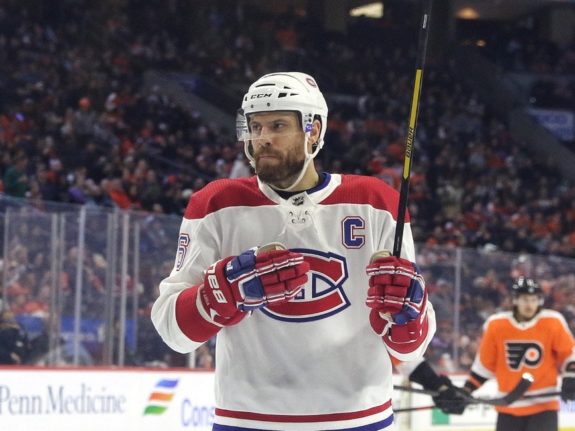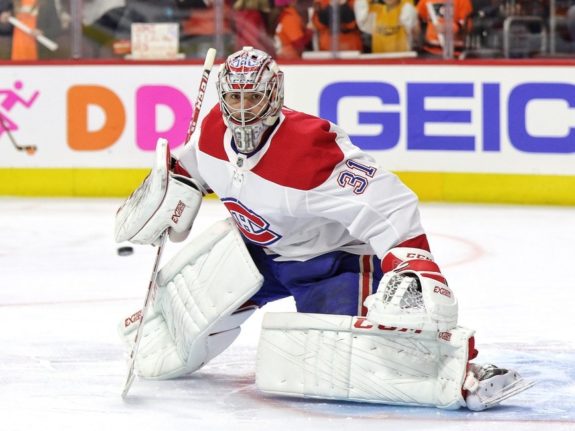The Montreal Canadiens headed home to the Bell Centre after earning a series split with the highly favored Toronto Maple Leafs. Canadiens fans, after the Game 1 victory, were feeling optimistic, but that feeling came crashing down after Toronto and their power play rediscovered their identity in Game 2.
Looking ahead to Game 4 the Canadiens can still make this series a long one. The lessons learned from Game 3 can be applied to the remainder of the series:
3. Special Teams
Special teams are an area the Canadiens must make improvements. The Maple Leafs’ power play (PP) has only struck twice in 13 opportunities for 15.4%. With the lineup they boast, that is woefully inadequate.
Led by Shea Weber, the Canadiens’ power play on the other hand has not scored. Despite having 10 man advantages, they haven’t been able to convert. They also couldn’t generate much momentum, either. There have been issues with winning faceoffs and also with controlled zone entries, however, the bigger issue has been a lack of offensive creativity from the players on the ice. The PP has been far too slow due mostly to the five players being too static. They haven’t been able to get the puck moving, either. All of this has come as the Leafs have been very aggressive in puck pursuit, forcing errors. If the Canadiens could rim the puck to an open man on the far side or make faster decisions with the puck, it may create the space they need to generate scoring opportunities.

The penalty kill (PK) has been strong, as noted above, they’ve killed off 84.6% or 11 penalties so far against a dangerous Leafs squad. Carey Price is a major reason for this as he has been able to make key saves shorthanded. The penalty killers have played a passive box and because of this, have spent far too much time in their own zone. The two goals allowed came after being trapped into their own zone for too long. The Habs could take a page from the Leafs and become a little more aggressive. When they are, the Habs PK is very dangerous, as seen in Game 1 when Paul Byron scored shorthanded. This means the Habs PK is outscoring the PP, something that needs to be rectified.
2. Safe Is Death
During the first two periods, head coach Dominique Ducharme had his troops playing a very conservative, defensive style. It’s almost as though they were rope-a-doping the Leafs, to draw them deep into the offensive zone in hopes a quick zone dump can become a transition play or an odd man rush. That could have been a plan to break the trap, yet, it also provided a talented team too many quality offensive chances.
The inability to clear the zone causes that plan to wither on the vine. The Canadiens’ lack of mobility on defence must be used in any planned adjustment. This kept Montreal in their zone too long, by using all their energy to play defensively, they were unable to focus on the offence. In the third period, they began to tighten their support in from the forwards, moving in deeper to allow for shorter passes which allowed them to be able to build their transition game and generate their forecheck.
Relying on excellent goaltending by Price isn’t going to score goals, and offense is what’s missing for the team to succeed. Also in the third, Ducharme began to give the ice time to his best performers, more importantly, he put elements together to maximize skills by playing his best-skilled performers together. Playing your best with the best when in need of a goal isn’t new, Guy Lafleur wasn’t centered by Bob Gainey when the Canadiens needed goals back in their dynasty days. Players do their best in roles that suit their skills.

For two periods, the Canadiens were playing safe and playing not to lose. Once they went all-in to play to win, they had their best results, dominating the Leafs 14 to 2 in shots on goal and looked dangerous every shift.
1. Youthful Excitement
Once Ducharme was no longer too preoccupied with his matchups, he began to let the kids play.
In the first two periods, Cole Caufield had only played seven minutes in all situations. Once Artturi Lehkonen got hurt and left the game, Caufield began to be double shifted. Why? Likely because his xGF% was hovering around 90% in his limited ice time earlier in the game.
Latest Canadiens Content:
- Canadiens’ Best Contracts for 2024-25
- Canadiens Could Benefit From New KHL Rules and Get Demidov Early
- Canadiens Can’t Guarantee Barre-Boulet 2024-25 Roster Spot
- NHL Rumors: Canadiens, Oilers, Sharks
- Revisiting Oilers’ Draisaitl-For-Subban Blockbuster That Almost Happened
Once he was given regular shifts next to 21-year-old Nick Suzuki, the two most dangerous offensive forwards paired together proved to be able to handle the best the Leafs’ defence could offer. Caufield finished the game with an 85.55 xGF% and Suzuki ended with a goal and an xGF of 79%, meaning the vast majority of the time on ice was spent in the Leafs’ zone generating scoring opportunities.
Another young player that made an impact was Jesperi Kotkaniemi. The only goalscorer in Game 2, the young center continued his strong play in Game 3. He led the team in hits with six, and also excelled in the faceoff circle with a 66.7% success rate. He also matched up well against Auston Matthews when Leafs’ head coach Sheldon Keefe began double shifting his top center to get him away from Phillip Danault.

The schedule in this series has made Game 4 the second game of a back-to-back. With two games in 24 hours, the younger players will be able to recover faster. Leaning on them will be important, especially after the top elements on the Leafs’ roster were heavily used. Placing the top offensive elements together and supporting a less mobile defence corps, who could be helped by adding a rested Alexander Romanov, the Canadiens could even up this series at two games apiece. As an added bonus, if the Canadiens can win one more game, they would guarantee that when they host Game 6, there would be fans in the Bell Center for the first time in the playoffs since 2017.
Stats provided by Natural Stat Trick